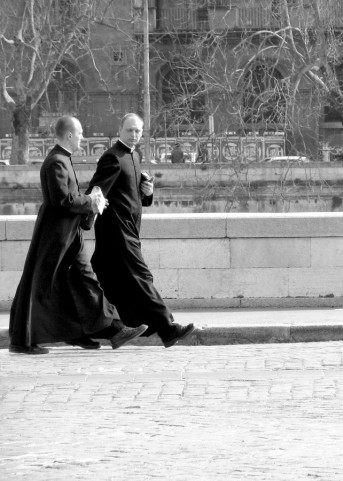Book ONE - The Night Religion of Primitives
Overview
The Characters
Nargess Behbaharni was an Iranian Muslim lecturer of Women’s Studies at Tehran University, and at her home whilst her family were being killed, she was kidnapped for lobbying against the punishment of execution by stoning (which thanks to the “Room”, she narrowly avoids). She would win an Amy Winehouse lookalike contest, albeit for the fact that she proudly wears her hijab wherever she travels. Single, aged mid twenties, determined, cynical, strong and bold, she is loyal to her culture and much of her religion. She is able to use the paranormal technique of remote influencing and viewing, made more powerful, when in partnership with the more sensitive and weaker, Monas.
Monas could be described as a ‘punk’ priest with attitude. A Roman Catholic with deeply unorthodox traits, he is a Father Brown fit for the 21st century. His priestly life is overshadowed by work carried out for secret service agencies such as “The Room”, and by the love he cannot fully express, for Nargess. Almost fashionably bald, early forties, with remnants of blond hair, he remains slim and very fit living on a diet of sea air and long walks. He was plucked from an Italian seminary by the Room (his spiritual advisor was a student of the Italian bi-locationist Fr Padre Pio), and has had paranormal ability since childhood. He (and Nargess) live in the true life remote village on the north east coast of Scotland, Pennan. He has been known to wear a discreet earring, and only occasionally, his clerical collar. He is principled, anti-modernist but progressive, with a caustic sense of humour. Whilst his mother failed to survive giving birth to him, his father was an alcoholic and Monas thrives on decent coffee, the music of Amy Winehouse, and endures insomnia fuelled by the nightmare visions of the work of painter Francis Bacon.
John (an employee of the ‘Room’): fanatically loyal employee of the Room, a quasi-secretive agency of the British government that engages with paranormal intelligence- based work. Eccentric loner/geek on intelligence matters and all things Asian in relation to political and diplomatic issues. Ultimately, capable of using a weapon when necessary. Think Uriah Heep, but with much more brain.
Abbess (Sister Mary): personal profile based on true story of Mary Bancroft who was lover of creator of the CIA, Allen Welsh Dulles, and recruits psychologist Carl Jung into the OSS as predecessor of the CIA during second world war, in Switzerland. Now at aged 98, is the Abbess of the Bothwell Monastery of Poor Clare nuns, based on true location outside of Glasgow. Unorthodox and dynamic for an ageing nun. Removes her veil, swears and has no hair as a result of leukaemia. Imagine Mo Mowlam, but with religion. Props her legs up on her desk when she is not being wheeled around. Churches connection with CIA reinforced by author’s true life research that revealed Avery Dulles, first RC Cardinal in Britain, was nephew to first CIA Director.
Michael Peter Grayson (MG) and Terence Shaun White (TW): Joint CEOs of BG Water International Corp, based in Canada. Revealed later in novel as sons of Mary Bancroft, fathered by Jung in IVF programme, ten years before Jung dies.
BG and the ideas surrounding the corporate activity of this fictional company, are based on ideas that are generated from authors original research into the Canadian Water Wars litigation current to Canada and that country’s, first political corruption scandal in a national context. MG and TW are the Gilbert and George of the international water utilities industry, about to take over from oil as the world’s most precious resource. In dress code and conduct, although biological twins they were separated at birth and raised by adoptive parents as part of an experiment. Their shared childhood in the Bronx, coupled with the paranormal abilities that they also share, brought them together in their youth and they become leading entrepreneurs in one of the world’s largest fresh drinking water companies. They are ruthless in character, deeply amoral and employ their abilities in the remote viewing and influencing arena for self advantage as well as to the advantage of western intelligence services.
The Plot
The setting is thoroughly contemporary, including the incorporation of events leading to the killing and locating of Osama Bin Laden, and the situation surrounding Libya and the family of the executed President of that country. There are historic backdrops to 9/11 and the development of paranormal programmes in the 1960s and 1970s including the CIA STARGATE programme and US Government PAPERCLIP projects. The novel also incorporates details of the CIA twenty four year funding programme for the use of paranormal means to advance intelligence gathering techniques.
This first book in the MONAS series typically explores modern science and religion, albeit with a water’s edge.
It piles fiction upon freshly revealed facts, with the true story of Mary Bancroft who was the lover of the creator of the Central Intelligence Agency, Allen Welsh Dulles (who recruited psychologist Carl Jung into the predecessor of the CIA during the Second World War). A Church connection with the CIA is incorporated into the fiction, with the research of the author revealing that Avery Dulles, the first Cardinal in Britain, was a nephew of the first Director of the CIA.
Based on ideas that are generated from Glen Reynolds’ original research and papers sent from those involved in the ongoing “Canadian Water Wars” litigation, two fictionalised CEO’s are revealed throughout the book, (who are the “Gilbert and George” of the international water utilities industry). In dress code and conduct, although biological twins, they were separated at birth and raised by adoptive parents as part of a paranormal experiment. Their shared childhood in the Bronx, coupled with the paranormal abilities that they also share, reunited them in their youth and they became leading entrepreneurs in one of the world’s largest fresh water corporations. They are ruthless in character, deeply amoral, and employ their abilities in the remote viewing and influencing arena for self advantage as well as to the advantage of western intelligence services.
The novel also incorporates within the fictional story as it unfolds, historic and ongoing allegations regarding accountancy practices employed by advisors to the British Monarchy (the essence of which was made available to Glen Reynolds and contained partly in affidavit evidence filed in the Canadian litigation,) in terms of the use of Royal Trusts based in Switzerland. And so the weaving of contemporary fact and fiction applies throughout the novel.
Through the paranormal workings of the Room, (a remote viewing and influencing centre), Monas and Nargess are united to work together against the Ophites. These are snake creatures that inhabit human beings and organisations, through and in the unconscious realm. Think cosmic wars akin to the Daleks, but using human beings that morph into snakes. The joint paranormal abilities that Monas and Nargess have, means that they are rescued from life threatening situations by the Room, to work with intelligence agencies in the fight against these creatures of the underworld. The Ophites are in essence, responsible for adversely affecting all of the bad things that have happened throughout human history, not least, current terrorism and water based wars.
Monas and Nargess discover together, the frustrations of their relationship which is not fulfilled physically. They are sent to investigate a murder of a nun at a convent, (following the novel’s development of their relationship, visiting art galleries and examining the fascination that Monas has for the artwork of Francis Bacon, something which nevertheless provides him with nightmare scenarios – a theme that perpetuates all the Monas works) . The novel explores the relationships between various Sisters at the monastery, and ultimately examines the circumstances surrounding a foetal abduction that takes place and the role of the corporate twin brothers in the remote paranormal work that is revealed as being carried out at the monastery.
Ultimately, the novel concludes in part with the situation where murder and corruption is allowed to proceed because of the seemingly greater issues at stake, in terms of defeating world terrorism and securing water resources regardless of consequence.






